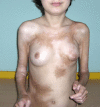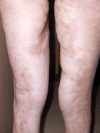Disabling pansclerotic morphea of childhood--unusual case and management challenges
- PMID: 20108512
- PMCID: PMC5654307
Disabling pansclerotic morphea of childhood--unusual case and management challenges
Abstract
Morphea, also known as localized scleroderma is a chronic disease of unknown etiology, characterized by fibrous deposition and obliteration of vessels in the skin. This disease has a wide clinical spectrum, ranging from mild hyperpigmented plaques to severe, invalidating generalized and pansclerotic forms. Disabling pansclerotic morphea of childhood is a rare and debilitating variant of localized scleroderma, characterized by a rapid progression of deep cutaneous fibrosis that involves the dermis and the subcutaneous adipose tissue but also fascia, muscles, and bone. Contractures and musculoskeletal atrophy develop and the disease has an invalidating and even fatal course. We present an unusual case of severe morphea in a 19-year-old girl, with a polymorphous clinical picture consisting of plaques, linear and pansclerotic, circumferential lesions, with symmetric, invalidating involvement of all limbs and explosive evolution with centripetal progression. This case emphasizes the unpredictable character of morphea evolution, the possible severe prognosis and the therapeutic challenges raised by the generalized, disabling forms of this disease.
Figures






Similar articles
-
Challenges in the diagnosis and treatment of disabling pansclerotic morphea of childhood: case-based review.Rheumatol Int. 2019 May;39(5):933-941. doi: 10.1007/s00296-019-04269-w. Epub 2019 Mar 5. Rheumatol Int. 2019. PMID: 30838436 Review.
-
Disabling pansclerotic morphoea of childhood.BMJ Case Rep. 2018 Feb 17;2018:bcr2017222132. doi: 10.1136/bcr-2017-222132. BMJ Case Rep. 2018. PMID: 29455178 Free PMC article.
-
Disabling pansclerotic morphea: clinical presentation in two adults.J Am Acad Dermatol. 2005 Aug;53(2 Suppl 1):S115-9. doi: 10.1016/j.jaad.2004.10.881. J Am Acad Dermatol. 2005. PMID: 16021158
-
Efficacy of bosentan in treatment of unresponsive cutaneous ulceration in disabling pansclerotic morphea in children.J Rheumatol. 2006 Dec;33(12):2538-40. J Rheumatol. 2006. PMID: 17143989
-
Juvenile case of multiple morphea profunda resulting in joint contracture that was successfully treated with cyclosporin A: A case report and review of the published works.J Dermatol. 2019 Apr;46(4):354-357. doi: 10.1111/1346-8138.14801. Epub 2019 Jan 31. J Dermatol. 2019. PMID: 30701571 Review.
Cited by
-
Challenges in the diagnosis and treatment of disabling pansclerotic morphea of childhood: case-based review.Rheumatol Int. 2019 May;39(5):933-941. doi: 10.1007/s00296-019-04269-w. Epub 2019 Mar 5. Rheumatol Int. 2019. PMID: 30838436 Review.
-
Phototherapy in Scleroderma.Dermatol Ther (Heidelb). 2016 Dec;6(4):519-553. doi: 10.1007/s13555-016-0136-3. Epub 2016 Aug 12. Dermatol Ther (Heidelb). 2016. PMID: 27519050 Free PMC article. Review.
-
Disabling pansclerotic morphoea of childhood.BMJ Case Rep. 2018 Feb 17;2018:bcr2017222132. doi: 10.1136/bcr-2017-222132. BMJ Case Rep. 2018. PMID: 29455178 Free PMC article.
-
Variant STAT4 and Response to Ruxolitinib in an Autoinflammatory Syndrome.N Engl J Med. 2023 Jun 15;388(24):2241-2252. doi: 10.1056/NEJMoa2202318. Epub 2023 May 31. N Engl J Med. 2023. PMID: 37256972 Free PMC article.
-
Adult-onset unilateral disabling pansclerotic morphea.Indian J Dermatol. 2014 May;59(3):316. doi: 10.4103/0019-5154.131459. Indian J Dermatol. 2014. PMID: 24891683 Free PMC article.
References
-
- Black CM. Scleroderma and fasciitis in children. Curr Opin Rheumatol. 1995;7:442–448. - PubMed
-
- Peterson LS, Nelson AM, Su WP. Classification of morphea (localized scleroderma) Mayo Clin Proc. 1995 Nov;70(11):1068–1076. - PubMed
-
- Irwin M. Freedberg, Arthur Z. Eisen, Klauss Wolff, K. Frank Austen, Lowell A. Goldsmith, Stephen Katz. Fitzpatrick's Dermatology in General Medicine
-
- Tony Burns, Stephen Breathnach, Neil Cox, Christopher Griffiths. Rook's Textbook of Dermatology
-
- Diaz-Perez JL, Connolly SM, Winkelmann RK. Disabling pansclerotic morphea of children. Arch Dermatol . 1980;116:169–173. - PubMed
Publication types
MeSH terms
Substances
LinkOut - more resources
Full Text Sources
Medical
